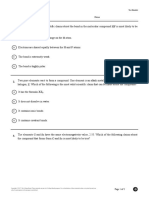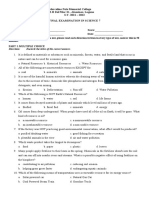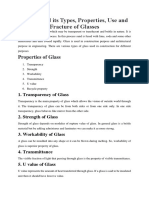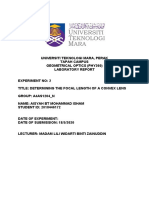MURANG’A HIGH SCHOOL
FORM 2 PHYSICS AUGUST HOLIDAY ASSIGNMENT - 2025
1. The figure 1 below shows a measuring cylinder, which contains water initially at level A. A
solid of mass 10g is immersed in the water, the level rises to B.
Figure 1
Determine the density of the solid [Give your answer to 1 decimal point.] [3marks]
2. Figure 2 (a) and (b) below shows capillary tubes inserted in mercury and water respectively.
Figure 2
It is observed that in water the meniscus in the capillary tube is higher than the meniscus in the
beaker. While in mercury the meniscus in the capillary tube is lower than the meniscus in the
beaker. Explain these observations. [2marks]
3. A hole of area 2.0 cm2 at the bottom of a tank 2.0 m deep is closed with a cork. Determine the
force on the cork when the tank is filled with water. [3 marks]
Page 1 of 8
�4. In the set up shown in the figure 3 below, water near the top of the boiling tube boils while at
the bottom remains cold.
Figure 3
Give a reason for the observation. [1 mark]
5. State any means of increasing the sensitivity of a liquid – in – glass thermometer.1 mark]
6. State one method of minimising friction between solid surfaces. [1 mark]
7. Define the term Centre of gravity of a body. (1 mark)
8. The diagram below shows apparatus used to observe the behaviour of smoke particle in air.
Figure 4
i. Why are smoke particles suitable for use in this experiment? (1 mark)
ii. State and explain the behaviour of the smoke particles (2 marks)
9. A student recorded the following measurements while using a meter rule: 5.32 cm, 4.9 cm and
8.013 cm. Which is the correct reading? Explain your answer (2 marks)
Page 2 of 8
�10. The figure below shows a wine glass. State and explain how the stability of the glass is affected
if it is filled with wine. (2 marks)
Figure 5
11.Distinguish between the terms ‘uniform velocity’ and ‘uniform acceleration’ (1 mark)
12. The figure 6, below shows a section of a ticker tape. The dots were made at a frequency of 50
Hz. Determine the acceleration of the trolley pulling the tape. (3 marks)
Figure 6
13. The diagram below represents a u-shaped glass tube sealed at one end and containing mercury.
Determine the pressure of the gas as shown in the diagram below (atmospheric pressure is 100000Pa)
(2 marks)
Figure 7
14.
a) Explain the following terms:
i. Streamline flow (1 mark)
ii. Turbulent flow (1 mark)
Page 3 of 8
�b) The figure below shows air flowing through a pipe of different cross-section areas. Two
pipes A and B are dipped into water as shown.
Figure 8
Explain the cause of difference in the levels of water in the pipes A and B. [2marks]
c) The figure below shows Bunsen burner. Explain how air is drawn into the burner when the
gas tap is opened. [3marks]
Figure 9
d) Water is not suitable for use as a barometric liquid. Explain (2 marks)
e) An aerofoil is dragged in the direction shown in air. Draw the arrangement of streamlines
below and above the aerofoil (draw at least two lines on either side).
(2 marks)
Figure 10
Page 4 of 8
�15.
a) Define the following terms: (2 marks)
i. Acceleration
ii. Displacement
b) The fig below shows a velocity – time graph for the motion of a certain body.
Figure 10
Describe the motion of the body in the region: [3marks]
i) OA
ii) AB
iii) BC
c) A car initially at 10m/s decelerates at 2.5m/s2. Determine,
i. Its velocity after 1.5 s [2marks]
ii. The distance travelled in 1.5 s. [2marks]
iii. The time taken for the car to stop. [2marks]
d) The figure below shows the velocity-time graph of the motion of a stone thrown vertically
upwards.
Figure 11
From the graph, determine the maximum height, s reached by the stone.
(Use space alongside the diagram) (2 marks)
Page 5 of 8
�16.
a) State the principle of moments (1mark)
b) A uniform metre-rule balances at the 35cm mark when a mass of 500g is placed at the 25cm
mark as shown in the figure 13 below.
Figure 12
Determine:
i. The mass of the meter-rule (3 marks)
ii. With the metre-rule remaining on the knife-edge at the 35 cm mark, a mass of 125g is
suspended from the 70 cm mark. The mass of 500g is moved until the rule is balanced.
Determine the new position of the 500g mass (3 marks)
c) The figure below shows a ring of a thin steel washer. Determine the centre of gravity of the
washer. (2 marks)
Figure 13
d) State two ways in which stability of a body can be increased (2 marks)
Page 6 of 8
�17.
a) State Hooke’s law (1 mark)
b) The diagram below shows three identical springs which obey Hooke’s law.
Figure 14
Determine the length X. (3 marks)
c) Sketch a graph of length of a helical spring against compressing force until the coils of the
spring are in contact (2 marks)
d) Distinguish between brittleness and stiffness (2 marks)
e) State any two applications of a compressed spring (2 marks)
18. State the reason why electricity transmission cables are left sagging between the
pylons. (1 mk)
19. The air pressure at the base of the mountain is 75.0cm of mercury while at the top it is
60.0cm.given that the average density of air is 1.25kgm-3 and the density of mercury is
13600kg/m3.calculatre the height of the mountain. (3mks)
20. State two factors that would raise the boiling point of water. (2 mks)
21. The level of water in a burette is 2.5cm3. 40 drops each of volume 0.05cm3 are added
to the Burette. What would be its new reading? (2 mks)
22. Explain how the efficiency of a vacuum flask is affected if the double-walled glass
surface is replaced with a double walled metal surface. (2 mks)
Page 7 of 8
�23. A body moving at 50m/s decelerates uniformly at 2/ms2 until it comes to rest. What
distance does it cover from the time it starts to decelerate to the time it comes to rest.
(3 mks)
24. Sketch a graph of displacement vs time for a body moving with variable velocity.
(3 mks)
25. Define the following terms:-
(a) Displacement - (1 mk
(b) Speed – (1 mk)
(c) Distance – (1 mk)
(d) Velocity (1 mk)
27. State two factors that affect surface tension of a liquid. (2 mks)
28. A stone is projected vertically upwards with a velocity of 30ms-1 from the ground.
Calculate:-
(a) The time it takes to reach the maximum height. (2 mks)
(b) the time of flight. (2 mks)
(c) The maximum height reached. (2 mks)
-1
(d) The velocity with which it lands on the ground (Take g = 10ms ) (2 mks)
29. (a) Define the term mass. (1 mk)
(b) The density of mercury is 13.6gcm . Find the volume of 2720g of mercury in m3.
-3
(3 mks)
30. How does temperature affect Brownian motion? (2 mks)
31. An object of height 5m is placed 10m away from a pinhole camera. Calculate:
(a) The size of the image if its magnification is 0.01 (3 mks)
(b) The length of the pinhole camera. (3 mks)
32. State four methods of magnetizing a magnetic material. (2 mks)
33. (a) State the principle of moments. (2 mks)
(b) A uniform metre rule pivoted at the centre is balanced by a force of 4.8N at 20cm
mark and other two forces F and 2.0N at the 66cm and 90cm marks respectively. Calculate
the force F. (4 mks)
Page 8 of 8





















































































